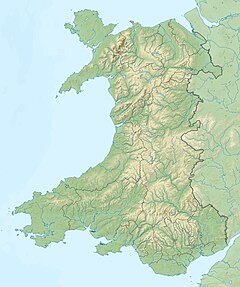Whiteford Lighthouse

Whiteford Point Lighthouse in 2006
|
|
|
Wales
|
|
| Location | Whiteford Point Gower Peninsula Swansea Wales |
|---|---|
| Coordinates | 51°39′09″N 4°15′04″W / 51.652587°N 4.251092°WCoordinates: 51°39′09″N 4°15′04″W / 51.652587°N 4.251092°W |
| Year first constructed | 1854 (first) |
| Year first lit | 1865 (current) |
| Automated | 1919 (gas) |
| Deactivated | 1926 |
| Foundation | wooden piles |
| Construction | cast iron tower |
| Tower shape | tapered cylindrical tower with balcony and lantern |
| Markings / pattern | originally black (bitumen coated) |
| Height | 13.5 metres (44 ft) |
| Range | 7 nautical miles (13 km; 8.1 mi) |
| ARLHS number | WAL-033 |
| Managing agent | Carmarthenshire County Council |
Whiteford Point Lighthouse is located off the coast at Whiteford Point near Whiteford Sands, on the Gower Peninsula, south Wales.
It is an unusual cast-iron lighthouse built in 1865 to a design by John Bowen (1825-1873) of Llanelli, by the Llanelli Harbour and Burry Navigation Commissioners to mark the shoals of Whiteford Point, replacing an earlier piled structure of 1854, of which nothing remains. It is the only wave-swept cast-iron tower of this size in Britain. The tower is 44 feet (13 m) high and stands just above low-water level. The base is about 24 feet (7.3 m) in diameter and rises gracefully to a diameter of 11 feet 6 inches (3.51 m) at lantern level. A pitched stone apron surrounds the base of the lighthouse.
The lighthouse sits on 88 wooden piles driven into glacial moraine. These are linked horizontally by walling pieces, using 500 cast-iron plants and bolts. These would have formed a box, probably square or octagonal, which would have been excavated and partially filled with concrete. The materials were delivered by boat and work undertaken during low tide.
The structure of the shell is formed from 105 bent and tapered cast-iron plates, each about 32 millimetres (1.3 in) thick, with an upstand flange on each side, and bolted with cast-iron bolts, each weighing 2 pounds (0.91 kg). There are eight levels of panel tapering to the sixth 'course'. The first three horizontal joints are covered by iron bands supported on brackets and topped with fillets of concrete.
During the 1870s vertical cracks developed in the plates of the lowest three rings. A local blacksmith called Powell made wrought-iron straps which were bolted to the flanges on each side of the cracked plates. At the time, the cracks were put down to lateral pressures arising from the settlement of the inner masonry, being composed of rough beach stones and 'bad' mortar. By 1884, 150 straps had been fitted. The compaction of the fill may have been compounded by movement (swaying) of the tower, reported in 1884 by the lighthouse keeper to have been 'several inches'. In 1885, the ground around the tower was strengthened with the addition of a concrete skirt 18 inches (46 cm) deep, bound by a 2-inch (5.1 cm) wide iron band, effectively anchoring the skirt to the base of the tower.
...
Wikipedia

